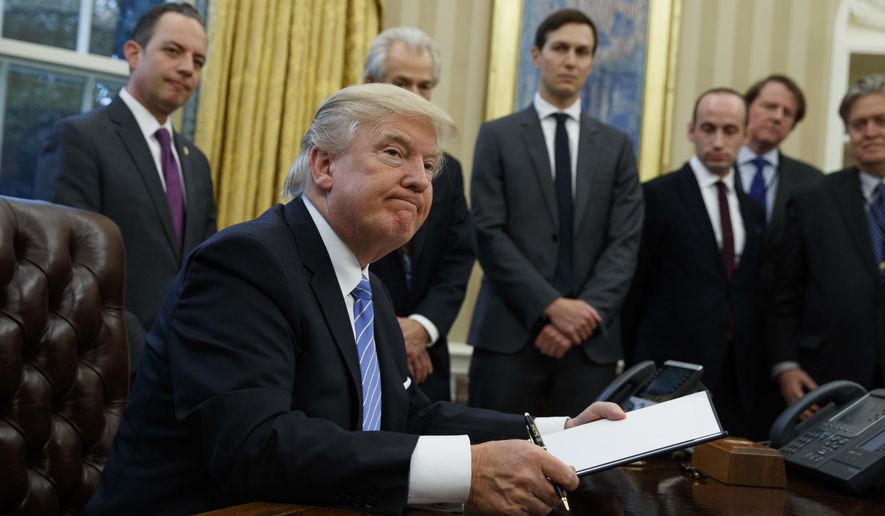WASHINGTON (AP) - President Donald Trump can do plenty on his own to unravel the Obama health care law, but some of those actions would create disruptions that undermine his administration’s early promises. Other less sweeping steps could open the way for big changes, but might not get as much notice.
Suspending enforcement of tax penalties on people who remain uninsured would win Trump immediate cheers from the political right for taking down a widely unpopular requirement. But experts say it would destabilize insurance markets by allowing healthy people to opt out, raising costs for taxpayers and remaining consumers. It would also risk a protracted court battle.
Less visible but just as important, the administration appears to have wide latitude to let states experiment with Medicaid funds and other federal financing. That could provide a pathway for GOP-led states to try their ideas.
For now, the executive order that Trump signed Friday night has changed very little. Consumers can still sign up on HealthCare.gov. The IRS is enforcing fines on people who remain uninsured, as it reviews Trump’s order. Insurers are providing medical benefits defined in the Affordable Care Act.
“The ACA is a big, complicated statute and the administration doesn’t have a Senate-confirmed secretary and the high-level political staff you would need to push through these proposals,” said Nicholas Bagley, a professor at the University of Michigan Law School. “Right now we are very much in a waiting game, but I would expect movement soon.”
Bagley and a colleague have identified about 25 areas in which the Trump administration could act unilaterally, from a requirement that women employees of religious-affiliated nonprofits have access to free birth control, to fines on people remaining uninsured. The scope of the executive order will be an issue at Tuesday’s Senate Finance Committee confirmation hearing for Trump’s health secretary pick, Georgia congressman Tom Price.
Still, there are practical and political limits on the administration. As the executive order made clear, changes to regulations have to follow a legally established process, which can take time. And actions that disrupt the insurance markets could backfire politically, because Trump has promised to provide insurance for everybody and lower costs, while other Republicans offered assurances they won’t “pull the rug out” from anyone currently covered.
Implementing changes would fall to three departments: Health and Human Services, Treasury, and Labor. Here’s a look at a few of the options, as well as their likelihood and potential impact.
___
INSURANCE MANDATE
The administration could decline to enforce the ACA’s requirement that most people carry health insurance, or it could add new “hardship” exemptions. For example, GOP lawmakers have called for an exemption in communities where only one health insurer continues to offer coverage.
Likelihood: High.
Impact: It depends on how sweeping the administration’s actions are. Declining to enforce the mandate is likely to trigger an exodus by insurers. Adding to the Obama administration’s list of exemptions might be feasible.
___
SUBSIDY LAWSUIT
A federal district judge has agreed with House Republicans that the Obama health law lacks specific legal authority to pay insurers billions to reduce consumers’ deductibles and copayments. The case is on hold, but unresolved.
If the Trump administration agrees with the House and stops the payments, insurers would bail.
“It would destroy the individual insurance market and throw millions off their coverage, including many Trump voters,” said Tim Jost, an emeritus professor at Washington and Lee University School of Law in Virginia.
Likelihood: A deal between the House and the administration could resolve the matter. Having won its legal argument, Congress could provide at least temporary spending authority.
Impact: High. However the issue is handled, it will be taken as a sign of Trump’s intentions.
___
BIRTH CONTROL COVERAGE
Under the health care law, women receive birth control at no additional cost as a preventive benefit. Houses of worship are exempt from the requirement, but women employees of church-affiliated nonprofits are covered. The new administration could rewrite the rules for nonprofits, or it could try to void the birth control requirement altogether.
Likelihood: An attempt to revise the rules for religious-affiliated nonprofits seems possible; a broader effort to void birth control coverage would be difficult.
Impact: Depends on the scope. Taking away a benefit for most women covered by workplace plans could provoke a backlash.
___
STATE FLEXIBILITY
A little-known provision of the ACA allows states to seek a “Section 1332” waiver that gives them broad leeway to manage several streams of federal health care funding, provided they cover about as many people and don’t add to the deficit. The Trump administration could rewrite the Obama administration’s guidance for states, making it less restrictive.
“They can do a lot by adopting a different attitude,” said economist Gail Wilensky, who ran Medicare for former President George H.W. Bush.
Likelihood: High. The Trump administration is also signaling flexibility on other red-state demands, such as work requirements for some low-income Medicaid recipients.
Impact: Uncertain. It would require major commitment and planning on the part of states.




Please read our comment policy before commenting.